Our input was featured in the Redfin blog about tips to create a butterfly garden.
Check it out:
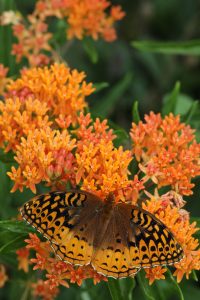
Great Spangled Fritillary on orange milkweed
Many people are familiar with monarchs and their migration, but most butterflies have their own unique life cycle. One is the beautiful Great spangled fritillary (speyeria cybele) They emerge from their chrysalis from late June to early July. Males will be seen searching for females. They will often be seen nectaring on milkweed flowers that are blooming at this time like common and orange milkweed. After they mate, males will die off and the females will go into a semi dormant like state, a summer nap if you will, and seldom be seen. Then in late summer early fall, they will start being seen again when they will start laying eggs.
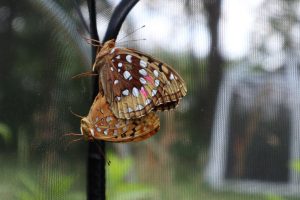
Butterflies overwinter in different ways. One of my favorites is the viceroy (the red spotted purple and the white admiral are identical). Viceroys overwinter as a little caterpillar in a half cocoon like contraption they build called a hibernacula. They eat most of a leaf and then build an open-ended silk structure within which they spend the winter. They secure the leaf to the stem to make sure they don’t fall to the ground like other leaves. In spring, when leaves come back out they come back out and resume eating. Looking for these hibernacula in winter can be a fun way to beat cabin fever. We had an ice storm yesterday, so I thought it would be fun to take a pic of a viceroy hibernacula coated in ice. In another month and a half or so, the little caterpillar will be back out and start eating again. (if you look close you can see the little threads the caterpillar used to make sure it stays attached to the stem)
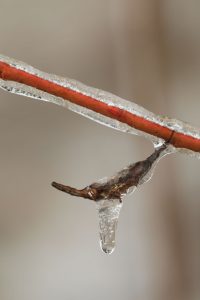
All swallowtail butterfly caterpillars in Michigan, regardless of species, have a unique defensive mechanism called osmeterium. When disturbed, the caterpillar is able to stick out and retract little horns at the top of their head. While the little orangish colored horns may themselves surprise a potential predator, the smell is what is really noticeable. I would describe it as a odiferous sweet smell. Many people describe as stinky and use the name “stink horns”. It’s never really bothered me. In fact, when I have been caterpillar hunting, it has often aided me in finding them, because the smell is so unmistakable. I know a swallowtail caterpillar is nearby when I smell it. This a a tiger swallowtail caterpillar with it’s osmeterium or “stink horns” out. When they stick them out they extend further than this but usually quickly retract much of it and then shortly after pull them entirely back in.
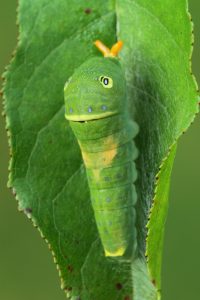
When I was a kid and would look for butterflies, tiger swallowtails always seemed like the prize. And the ones that always impressed me most were the ones with so much blue on the hind wings. Wow, did they just pop! When I got a bit older I learned that many swallowtails are sexually dimorphic, which means the males and females are distinctly different looking. Not all are like this, such as the giant swallowtail. Both sexes look similar. But with the tiger swallowtails, black swallowtails, and spicebush swallowtails, females have noticeably more blue on the hind wing. (Well, with the spicebush swallowtail, the males are a more blue-green and the females a metallic blue). Many other swallowtail species across the world are also sexually dimorphic. A phrase that many butterfly enthusiasts will say to remember this is “girls have blue skirts” In this picture we took you can clearly see the difference in the female on top and the male on the bottom. Often during the summer we will be approached by people who share pictures of swallowtails in the yard and we’ll react, “what a beautiful female (or male)!” “But how can you tell?” Girls have blue skirts.

One thing that never seems to quit fascinating me is watching a newly hatched (eclose) butterfly or moth expand it’s wings. Comparing the size of the butterfly/ moth to the pupa it came out of is impressive. Watching the wings go from shriveled looking little things to large wings capable of flight is a marvel. The luna moth is even more intriguing to me because it’s tails are tucked in and don’t flop out until further in the wing development as you can see in this series of photos that I took.
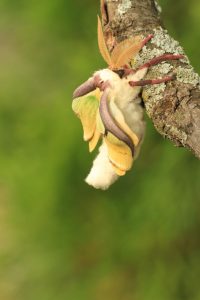
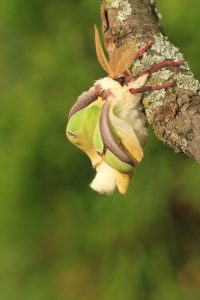
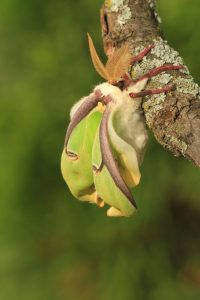
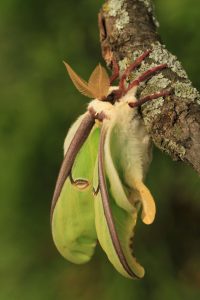
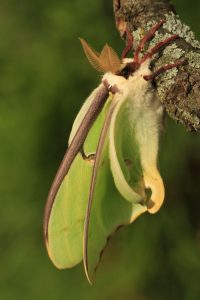
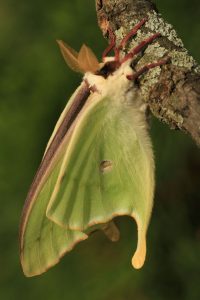
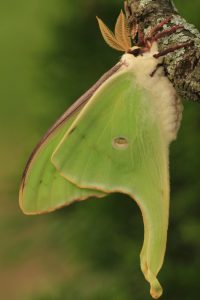
It is still winter here in Southwest Michigan and if you are like me, longing for warmer weather and “butterfly season” to begin. The term “Cabin Fever” feels like it has a lot of meaning. Although most butterflies aren’t really active until at least May, there are signs it’s getting closer. Spring officially starts on March 20, but you may hear the term meteorological spring which basically divides the seasons by month. So March, April, May, is classified as spring. Still doesn’t feel like it, but this is the first week in seemingly forever that the high temp every day is forcasted to get above 32F/0C. It also appears that some animals have started to notice.
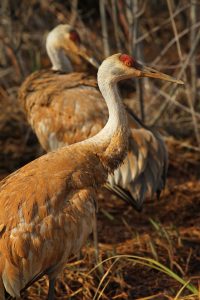

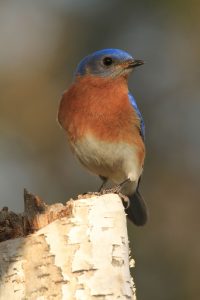
There are some birds that do not overwinter very much further south than Michigan. Some might not even migrate at all but find a good location to hunker down nearby. When a little warmth arrives they start moving around looking for suitable future nesting spots, returning to established ones, and establishing territory. Some that I have seen (or heard) recently are the sandhill crane, bluebirds, and killdeer. All who have easily recognizable calls, and in the case of the sandhill crane…loud!
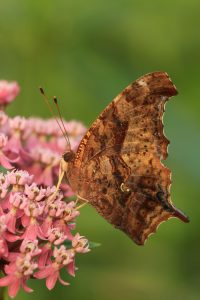
So what about butterflies? It may be a while yet, but some butterflies overwinter as adults, finding safe places to overwinter. The mourning cloak, questionmark, and comma butterflies all overwinter this way. They have been known to come out on warm sunny winter and early spring days to sun themselves and possibly feed on oozing tree sap (another spring sign) I haven’t seen one yet, but someday soon?
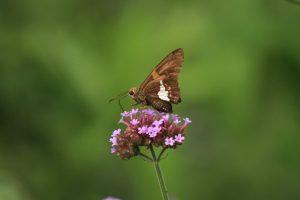
(Silver spotted skipper on tall verbena)
It makes sense that native plants are great for pollinators as they have a history of working together. Even so, we’ve got some favorites that aren’t native too. Here are our four favorites that we sell: Tithonia, Tall Verbena, lovage, and rue.

(Monarch butterfly on tithonia flower)
Tithonia (also called Mexican sunflower) is native to Mexico and from what we have read, is a common roadside plant in areas. It gets incredibly tall, 5-8 ft and covered in bright orange flowers that pollinators love. It loves the summer heat and grows like crazy when hot and it’s tolerant of dryer soils. This plant is not only a pollinator magnet, but also loved by hummingbirds. It continues blooming right up to frost and has lots of nectar for migrating monarchs. I tell people who enjoy photography to get these plants and then just go stand out by them in summer. The action never ends. The only thing that is a downer is that it gets so big, some people don’t have room and that it is an annual (gotta replant each year), which surprises many because of it’s size.
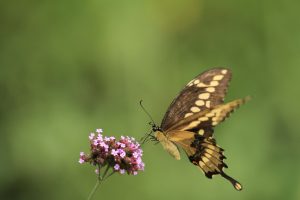
(Giant swallowtail nectaring on tall verbena)
Tall Verbena is another fantastic nectar plant that butterflies and other pollinators love (hummingbirds too!). It gets 3-5ft with narrow stems and light pink/ purple flowers. It’s a very adaptable plant. We get a lot of daytime flying sphinx moths (hummingbird clearwing/ white lined sphinx) at ours. Zebra swallowtails seem particularly fond of it too. It’s foliage is very similar to it’s native relatives, blue vervain and hoary vervain. This is another annual. One negative I have noticed about it is that it is a good self seeder and one needs to watch to make sure it doesn’t show up where it is not wanted.
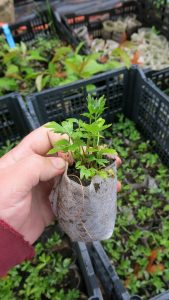
(lovage starter plant)
Lovage is a perennial herb that gets the nickname “poor mans celery” because of it’s similar taste. It is in the same family as celery and other garden plants like dill, fennel, and carrot. Like these it is the host for black swallowtails. The reasons I think these are great plants is that unlike it’s garden relatives, lovage is a perennial. It also loves cool weather and grows quickly in the spring. When the overwintered black swallowtails start emerging from their chrysalis in spring, lovage has lots of foliage for their caterpillars. Lovage doesn’t really like heat, so they can look haggard in summer, but bounce right back in fall and survive frosts till we get a good freeze.
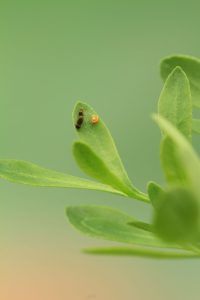
(Baby Giant swallowtail caterpillar and egg on rue)
Rue is another perennial herb. It generally stays under 3ft and has woody looking stems from which it sends out new growth in spring. It gets little yellow flowers in early summer. I often get asked what pollinators like the flowers and it doesn’t seem to be a favorite of many, but the one I do notice on them are mud dauber wasps. Mud daubers are beautiful (black and metallic blue/ purple), not aggressive like some wasps, and good pollinators. The great thing about rue is that it is the host for both giant swallowtails and black swallowtails, which use hosts from different families. With a rue plant you can find caterpillars of either and witness either species female butterflies laying eggs. One thing to be careful of is that the foliage can cause a rash in susceptible people.
We anticipate having all these plants available this season.

(Viceroy butterfly on tithonia)
